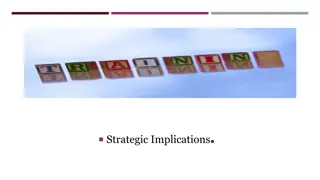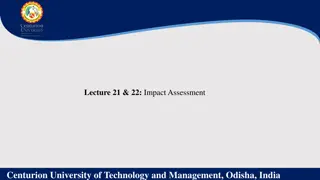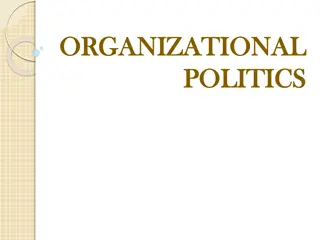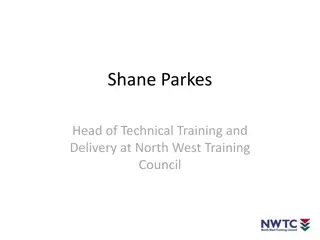Understanding Training Climate and Its Impact on Organizational Development
Training climate plays a crucial role in shaping the effectiveness of formal and informal training programs within an organization. Factors such as managerial support, job support, and organizational support significantly influence how employees engage with training initiatives. Creating a conducive training climate involves enabling objectives, recognizing learner characteristics, and fostering a culture that values continuous learning and professional development.
Download Presentation
Please find below an Image/Link to download the presentation.
The content on the website is provided AS IS for your information and personal use only. It may not be sold, licensed, or shared on other websites without obtaining consent from the author. Download presentation by click this link. If you encounter any issues during the download, it is possible that the publisher has removed the file from their server.
Presentation Transcript
Training Climate And Pedagogy Shweta Patil
TRAINING CLIMATE Simply stated, climate is what it feels like to work somewhere, how motivating that is, and consists of six clear elements; clarity, commitment, standards, responsibility, recognition and teamwork - all of which can be measured and managed. Various influences in an organization that can affect the effectiveness of the formal and informal training. Although many variables may influence the effectiveness of the training and development efforts, the organization s training climate appears to be playing an important role.
Managerial Support (MS): 1. Supervisors give recognition and credit to those who apply new knowledge and skills to their work. 2. Supervisors match associates needs for personal and professional development with opportunities to attend training. 3. Independent and innovative thinking are encouraged by supervisors. 4. Top management expects high levels of performance at all times. 5. Top management expects continuing technical excellence and competence.
Job Support (JS): 1. Gaining new information about ways to perform work more effectively is important in this organization. 2. Job assignments are designed to promote personal development. 3. Learning new ways of performing work is valued in this organization. 4. Work assignments include opportunities to learn new techniques and procedures for improving performance. 5. There is a strong belief that continuous learning is important to successful job performance.
Organizational Support (OS): 1. There is a performance appraisal system that ties financial rewards to use of newly acquired knowledge and skills. 2. This organization offers excellent training programs. 3. Employees are provided with resources necessary to acquire and use new knowledge and skills. 4. There are rewards and incentives for acquiring and using new knowledge and skills in one s job. 5. This organization rewards employees for using newly acquired knowledge and skills on the job.
ANOTHER FACTORS, WHICH NEEDS TO BE CONSIDERED IS HOW TO CREATE A TRAINING CLIMATE IN THE TRAINING ROOM. 1.ENABLING OBJECTIVES - Identify characteristics of how people learn - Explain how groups form and develop - Use effective presentation skills - Introduce a presentation - Use questioning techniques - Summarize a presentation
2.CHARACTERISTICS OF LEARNERS Require learning to be relevant Are highly motivated if they believe learning is relevant Need participation and active involvement in the learning process Desire a variety of learning experiences Desire positive feedback Have personal concerns and need an atmosphere of safety Need to be recognized as individuals with unique backgrounds, experiences and learning needs Must maintain their self-esteem Have high expectations for themselves and their trainer Have personal needs that must be taken into consideration
3. INVOLVING PARTICIPANTS Allowing participants to provide input regarding schedules, activities and other events Questioning and feedback Brainstorming and discussions Hands-on work Group and individual projects, Classroom activities
4.USE A VARIETY OF METHODS Audiovisual aids Illustrated lectures Demonstrations Brainstorming Small group activities Group discussions Role plays and case studies Guest speakers
5.USE THE POSITIVE FEEDBACK Give verbal praise either in front of other participants or in private Use positive responses during questioning Recognize appropriate skills while coaching Let the participants know how they are progressing toward achieving learning objectives
6.TREAT PARTICIPANTS AS INDIVIDUALS Use participant names as often as possible Involve all participants as often as possible Treat participants with respect Allow participants to share information with others
7.MAINTAIN SELF-ESTEEM Reinforce those practices and beliefs embodied in the course content Provide corrective feedback in an appropriate manner Provide training that adds to their sense of competence and self-esteem Recognize participants own career accomplishments
8.INDIVIDUALS BECOME GROUP They share a common purpose They share a common experience in attending the course Each member s contributions and questions are valued and respected An open and trusting climate develops The members pay attention to how they work together
9.UNDERSTAND GROUP DYNAMICS Observe Develop increased awareness Discuss observations with co-trainers Develop options to support the group
10.TO MOVE TOWARDS LEARNING GOALS Structure Direction Leadership
11.EFFECTIVE PRESENTATION SKILLS Follow a plan and use trainer s notes Communicate in a way that is easy to understand Maintain eye contact with participants Project your voice Avoid the use of slang or repetitive words, phrases or gestures Display enthusiasm Move around the room Use appropriate audiovisuals Be sure to ask both simple and more challenging questions Provide positive feedback Use participant names Display a positive use of humor Provide smooth transitions between topics Be an effective role model
12.PURPOSE OF INTRODUCTION Capture interest Make participants aware of the clinical trainer s expectations Help foster a positive training climate
13.INTRODUCTION TECHNIQUES Reviewing the objectives Asking a series of questions about the topic Relating the topic to previously covered content Sharing a personal experience Relating the topic to real-life experiences Using a case study or problem-solving activity Using a videotape or other audiovisual aid Using an imaginative transparency Making a provocative statement Giving a classroom demonstration Using a content expert Using a game, role play or simulation Relating the topic to future work experiences
14.QUESTIONING TECHNIQUES Ask a question of the entire group Target the question to a specific participant State the question, pause and then direct the question to a specific participant The key in asking questions is to avoid a pattern Use participant names during questioning Repeat a participant s correct response Provide positive reinforcement
15.PARTICIPANTS RESPONSES Use participant names during questioning Repeat a participant s correct response Provide positive reinforcement
PEDAGOGY IT IS -- The strategies, techniques, and approaches that teachers /trainers can use to facilitate learning. Pedagogy is the ART or SCIENCE of being a TEACHER OR TRAINER. The word "PEDA" refers to CHILDREN , which is why some like to make the distinction between pedagogy (teaching children) and ANDRAGOGY(teaching adults). Pedagogy is also sometimes referred to as the correct use of teaching strategies.

















































